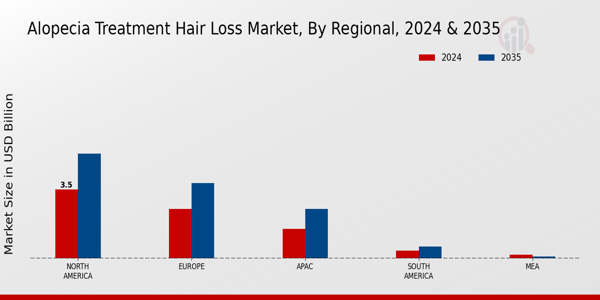Rising Disposable Incomes
The increase in disposable incomes across various demographics is a significant driver for the Alopecia Treatment Hair Loss Market. As individuals have more financial resources at their disposal, they are more likely to invest in personal care and aesthetic treatments, including those for hair loss. This trend is particularly evident in emerging markets, where a growing middle class is becoming increasingly concerned about appearance and self-image. The willingness to spend on advanced hair restoration treatments, such as hair transplants and specialized products, is likely to boost market revenues. Furthermore, the availability of financing options for expensive procedures may also contribute to increased accessibility for consumers. As disposable incomes continue to rise, the Alopecia Treatment Hair Loss Market may experience substantial growth, driven by a more affluent consumer base.
Growing Awareness and Education
The increasing awareness and education surrounding alopecia and its treatments are vital drivers for the Alopecia Treatment Hair Loss Market. Campaigns aimed at educating the public about the causes and available treatments for hair loss are gaining traction. This heightened awareness is likely to encourage individuals experiencing hair loss to seek professional help, thereby expanding the market. Additionally, social media platforms are playing a crucial role in disseminating information and personal experiences related to alopecia, which may foster a supportive community. As more people become informed about their options, the demand for various treatment modalities, including topical solutions and surgical interventions, is expected to rise. This trend could lead to a more competitive landscape within the Alopecia Treatment Hair Loss Market, as companies strive to meet the evolving needs of consumers.
Increasing Prevalence of Alopecia
The rising incidence of alopecia is a pivotal driver for the Alopecia Treatment Hair Loss Market. Studies indicate that approximately 50 million men and 30 million women experience some form of hair loss in their lifetime. This growing prevalence is likely to escalate demand for effective treatment options, thereby propelling market growth. As awareness about alopecia increases, more individuals are seeking solutions, which could lead to a surge in product development and innovation within the industry. Furthermore, the psychological impact of hair loss is prompting patients to pursue treatments, thus expanding the consumer base for the Alopecia Treatment Hair Loss Market. The increasing number of dermatological clinics and specialized hair restoration centers is also contributing to the accessibility of treatments, which may further stimulate market expansion.
Advancements in Treatment Technologies
Technological innovations in hair restoration treatments are significantly influencing the Alopecia Treatment Hair Loss Market. Recent advancements, such as platelet-rich plasma therapy and low-level laser therapy, have emerged as effective solutions for hair regrowth. These technologies not only enhance treatment efficacy but also improve patient satisfaction, which is crucial for market growth. The introduction of minimally invasive procedures is attracting a broader demographic, including younger individuals who are increasingly concerned about hair loss. Moreover, the integration of artificial intelligence in treatment planning and personalized medicine is likely to revolutionize the industry. As these technologies become more mainstream, they may lead to increased investment in research and development, further driving the growth of the Alopecia Treatment Hair Loss Market.
Changing Demographics and Lifestyle Factors
The evolving demographics and lifestyle factors are shaping the landscape of the Alopecia Treatment Hair Loss Market. An aging population, particularly in developed regions, is contributing to a higher prevalence of hair loss, thereby increasing the demand for treatment options. Additionally, lifestyle factors such as stress, poor diet, and environmental influences are becoming more recognized as contributors to hair loss. This awareness is prompting individuals to seek preventive measures and treatments at an earlier age. The trend of prioritizing personal appearance and grooming among younger generations is also influencing market dynamics. As these demographic shifts continue, the Alopecia Treatment Hair Loss Market is likely to adapt, offering a wider range of products and services tailored to meet the diverse needs of consumers.


















Leave a Comment